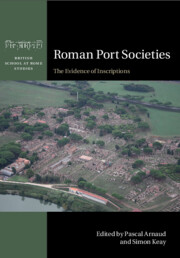Refine search
Actions for selected content:
23990 results in Ancient history
Contents
-
- Book:
- The Athenian Empire
- Published online:
- 19 October 2020
- Print publication:
- 05 November 2020, pp v-v
-
- Chapter
- Export citation
7 - The Ionian War and Loss of Empire, 413–404 BC
-
- Book:
- The Athenian Empire
- Published online:
- 19 October 2020
- Print publication:
- 05 November 2020, pp 123-139
-
- Chapter
- Export citation
Guide to Further Reading
-
- Book:
- The Athenian Empire
- Published online:
- 19 October 2020
- Print publication:
- 05 November 2020, pp 146-147
-
- Chapter
- Export citation
Bibliography
-
- Book:
- The Athenian Empire
- Published online:
- 19 October 2020
- Print publication:
- 05 November 2020, pp 161-169
-
- Chapter
- Export citation
Appendices
-
- Book:
- The Athenian Empire
- Published online:
- 19 October 2020
- Print publication:
- 05 November 2020, pp 148-160
-
- Chapter
- Export citation
Appendix C - Glossary of Numismatic Terms
-
- Book:
- The Athenian Empire
- Published online:
- 19 October 2020
- Print publication:
- 05 November 2020, pp 158-160
-
- Chapter
- Export citation
Appendix B - Hoards
-
- Book:
- The Athenian Empire
- Published online:
- 19 October 2020
- Print publication:
- 05 November 2020, pp 152-157
-
- Chapter
- Export citation
2 - The Silver Owl Coinage of Athens
-
- Book:
- The Athenian Empire
- Published online:
- 19 October 2020
- Print publication:
- 05 November 2020, pp 13-38
-
- Chapter
- Export citation
Chronological Table
-
- Book:
- The Athenian Empire
- Published online:
- 19 October 2020
- Print publication:
- 05 November 2020, pp xxiii-xxiv
-
- Chapter
- Export citation
1 - Introduction
-
- Book:
- The Athenian Empire
- Published online:
- 19 October 2020
- Print publication:
- 05 November 2020, pp 1-12
-
- Chapter
- Export citation
Table
-
- Book:
- The Athenian Empire
- Published online:
- 19 October 2020
- Print publication:
- 05 November 2020, pp xx-xx
-
- Chapter
- Export citation
Abbreviations
-
- Book:
- The Athenian Empire
- Published online:
- 19 October 2020
- Print publication:
- 05 November 2020, pp xxv-xxv
-
- Chapter
- Export citation
Figures
-
- Book:
- The Athenian Empire
- Published online:
- 19 October 2020
- Print publication:
- 05 November 2020, pp vi-xviii
-
- Chapter
- Export citation
Copyright page
-
- Book:
- The Athenian Empire
- Published online:
- 19 October 2020
- Print publication:
- 05 November 2020, pp iv-iv
-
- Chapter
- Export citation
5 - The Archidamian War, 431–421 BC
-
- Book:
- The Athenian Empire
- Published online:
- 19 October 2020
- Print publication:
- 05 November 2020, pp 89-103
-
- Chapter
- Export citation
6 - The Peace of Nikias and the Rethinking of Monetary Policy, 421–413 BC
-
- Book:
- The Athenian Empire
- Published online:
- 19 October 2020
- Print publication:
- 05 November 2020, pp 104-122
-
- Chapter
- Export citation
3 - Coinages of the Allied Cities
-
- Book:
- The Athenian Empire
- Published online:
- 19 October 2020
- Print publication:
- 05 November 2020, pp 39-72
-
- Chapter
- Export citation

The Cosmos in Ancient Greek Religious Experience
- Sacred Space, Memory, and Cognition
-
- Published online:
- 04 November 2020
- Print publication:
- 29 October 2020

Roman Port Societies
- The Evidence of Inscriptions
-
- Published online:
- 30 October 2020
- Print publication:
- 03 September 2020
Manuscripts
-
- Book:
- Livy: <I>Ab urbe</I> <I>condita</I> Book XXII
- Print publication:
- 29 October 2020, pp -
-
- Chapter
- Export citation
